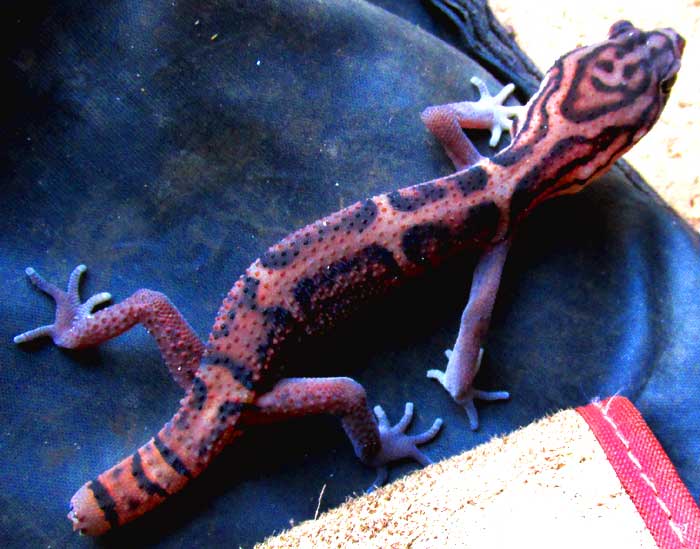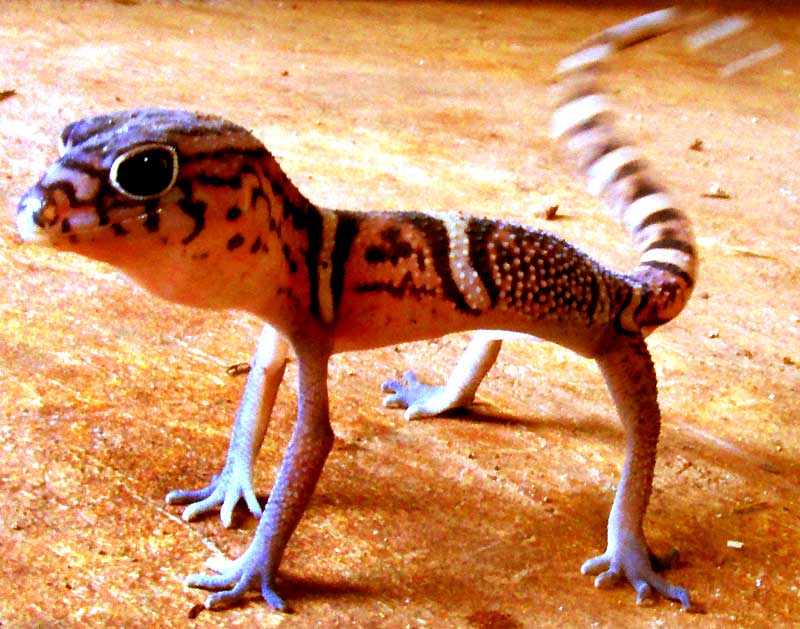Excerpts from Jim Conrad's
Naturalist Newsletter
issued October 29, 2019 from near the forest just west of Tepakán; elev. ~9m (~30 ft), N21.053°, W89.052°; north-central Yucatán state, MÉXICO

The above Yucatan Banded Gecko, COLEONYX ELEGANS, had moved into a black bag resting on my hut's floor overnight. More info on the species below:
issued November 22, 2019 from near the forest just west of Tepakán; elev. ~9m (~30 ft), N21.053°, W89.052°; north-central Yucatán state, MÉXICO
In early morning when I walked into the hut, our friend had taken up position in the very center of the floor, very unlike other reptiles which normally keep a low profile. In this provocative spot, he'd raised himself high on his legs, was puffing out his throat, and slowly moving his raised tail, as shown below.

The light was so dim that I had to use a shutter speed of about one second, accounting for the blurred tail. The gecko didn't budge as I got close. In fact, at one point he rushed at me. Though all this displaying was pure bluff, if was effective enough to scare me for half a second.
from the May 2, 2010 Newsletter issued from Hacienda Chichen Resort beside Chichén Itzá Ruins, central Yucatán, MÉXICO; limestone bedrock, elevation ~39m (~128ft), ~N20.676°, ~W88.569°
A YUCATÁN BANDED GECKO
Sweeping out the old church's storeroom where I lived for nearly six months one of my friends pointed to a small heap of debris and said that a little critter was hidden beneath it, a bicho. I poked at it with a finger and the Yucatán's prettiest gecko, a Yucatán Banded Gecko, COLEONYX ELEGANS, waddled onto the open floor. You can see just how pretty the species is above.
The face with its big eyes with vertically elliptical pupils and -- unusual for geckos -- well-developed eyelids, can be admired below:

Campbell in his Amphibians and Reptiles of Northern Guatemala, the Yucatán, and Belize tells us that Yucatán Banded Geckos are mostly nocturnal and, lacking adaptations for climbing, live under rocks and logs. This is my second time to meet the species, and both times it was in a trashy corner of an abandoned room.
The species name elegans, or "elegant," probably coincides with your own feeling that this is a particularly pretty, wonderful little creature. This wasn't the opinion of my shaman friend José who stared at my picture with disgust in his face, saying that an even uglier such a thing usually could be found in the dark corners of another of the old church's storerooms. (When I went to look, it was the Turnip- tailed Gecko I told you about last November at www.backyardnature.net/yucatan/turntail.htm)
José continued by telling me that our Yucatán Banded Gecko deals a deadly sting with the tip of its tail. This is a belief I've heard again and again throughout the Yucatán but of course none of our lizards sting with their tail-tips.
I'm always amazed by the Maya people's enormous store of information about plants, especially medicinal ones. However, in the many cultures of the 40 or so countries I've visited, I've never encountered any people so misinformed and hysterical about reptiles as the Maya. My friend José is actually a level-headed and very smart individual, but nothing I could say could convince him of the Yucatán Banded Gecko's charming innocence.
One reason people may get especially hysterical over the presence of Yucatán Banded Geckos may be because of the species' bold patterning, which in Nature often serves as a warning for truly dangerous organisms. Another might be the species' behavior when disturbed. It raises its body, inflates its throat, and waves its tail, maybe even making a soft purring sound... But that's all bluff.
I've often wondered whether the Maya's spectacular fear of reptiles might be an echo of former times when the Plumed Serpent Quetzalcoatl was worshiped and the gods demanded human sacrifice, and endless warring to capture those who would be sacrificed.